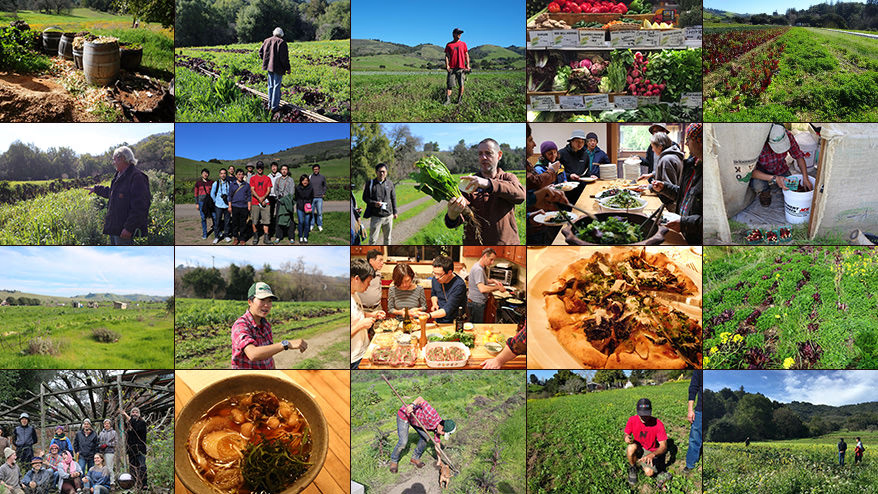I'm Manabe, head of the production department.
Last time I introduced the " Food Hub Project - Regional Revitalization and Locally Produced Food " in Kamiyama Town, Tokushima Prefecture. Recently, I went on a fact-finding trip with project members to the San Francisco Bay Area on the west coast of the United States.
This inspection was carried out as part of a unique "study program" undertaken by Kamiyama Town.
- Small number of people (improving the quality of the trip)
- New combinations (adding diversity)
- Multiple reporting sessions (repeatedly held for a wide range of audiences from various perspectives)
The program was devised by project member Nishimura Yoshitetsu ( Living World ), and its aim is to go beyond being just a simple inspection trip.
The diverse members who participated this time are as follows:
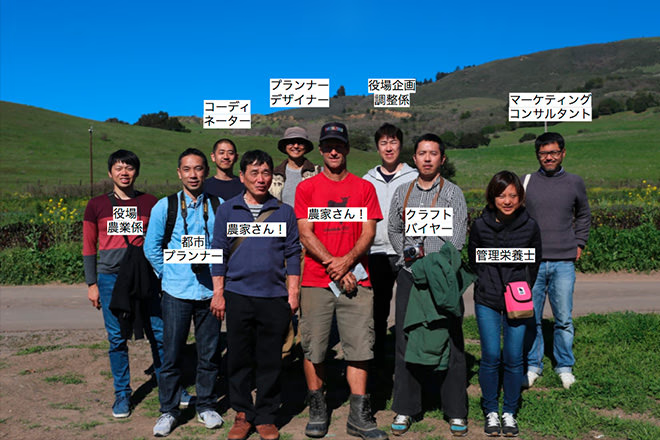
The nine of us are the agriculture section of the Kamiyama Town Hall, key members in building a strategy for regional revitalization (town hall planning and coordination section, urban planner, planner/designer), a Kamiyama farmer, a lifestyle shop owner originally from Kamiyama, a marketing consultant (our company president, Hayashi), a registered dietitian, and myself as a coordinator. We are made up of members with truly diverse perspectives. The man in the red T-shirt in the center is Joe, a farmer from California.
Why the San Francisco Bay Area?
This is purely my personal opinion, but I think the San Francisco Bay Area is a very special place, with a culture and community of local food that has been rooted for 40 years around a single organic restaurant called Chez Panisse in Berkeley.
Many of the chefs from that restaurant have gone on to start their own food businesses. It's a place where a down-to-earth food culture is nurtured by connecting with and cooperating with producers, rather than competing with each other.
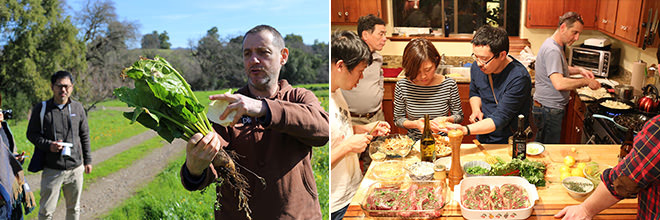
What was important to me on this trip was to have former head chef of Chez Panisse, Jerome Waag, cooperate as my "travel guide" and to tour the farmland with him, to see, hear, feel, cook, eat, and absorb as much of the culture as possible. In addition, I aimed to learn from examples of the idea of "food hubs," which is becoming more and more popular in the United States, centering on the entire flow of food, which is the food chain (agriculture → processing → distribution → sales → eating and drinking).
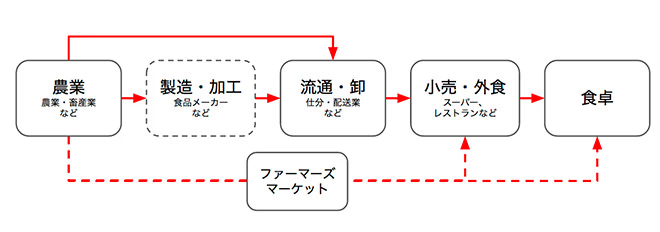
In this article, we will focus on the "agriculture" part of the food chain from among the various events that occurred during the tour, and introduce the stories of three people who farm in their own unique style.
People's Plant & Nature Plant
Grow plants for people and plants for nature.
Bob Cannard / Green String Farm

In order to practice his ideal agriculture, Bob Canard rented land that was previously unusable as a field due to turkey manure, improved the soil, and has been farming for 30 years. The vegetables he harvests are sold only through his own direct sales store and under an exclusive contract with Chez Panisse.
Our tour guide, Jerome, kindly showed us his "home garden," which is usually off-limits to the public. Bob, who also runs a school called Green String Farm Institution to train young farmers, spoke passionately about the importance of People's Plants and Nature Plants.
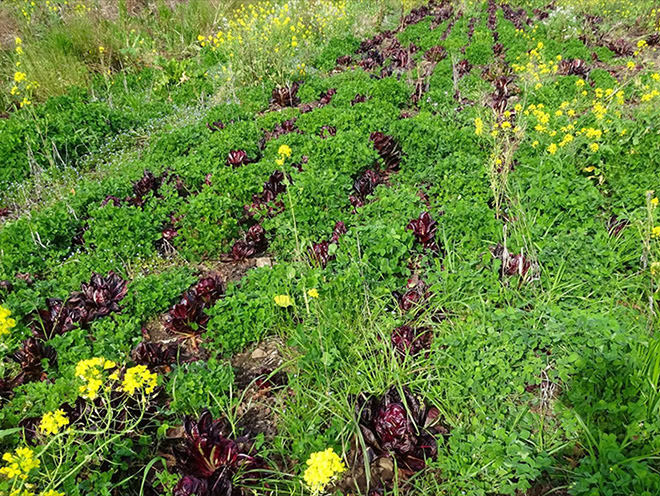
People's Plant Chicory (purple) Nature Plant Clover (green)
"In order to grow 'plants that people eat' and 'plants that nature eats' at the same time, TIME, SPACE and SHARING are important. Grow the plants that people eat first, followed by the plants that nature eats (needs). Then, by the time the plants that nature eats have covered most of the field, the harvest of the plants that people eat is finished. This cycle is important, and what's crucial is how we return organic matter to the soil."
Modern farming methods are focused only on efficiently growing things for people to eat, and do not grow things for the microorganisms in the soil to eat. This causes the microorganisms to disappear and the soil to become depleted. As a result, we have to start using chemicals.
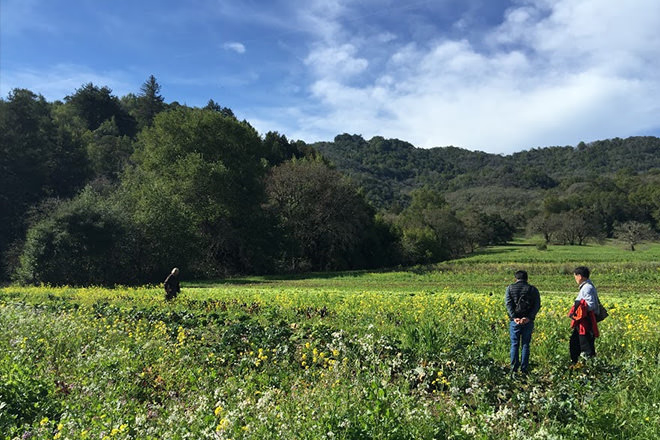
Hakuto and his son (father, a Kamiyama farmer, son, agricultural clerk at Kamiyama Town Hall) staring at the field
Kamiyama farmer Shigeru Shirato said, "It reminds me of the rice fields where milk vetch used to grow," and his son Kaoru, who works in the agriculture department at the town hall, said, "It's not a field, it's a flower field, a garden." I was really impressed when Bob said, "Japan must have had fields like this in the past, too."
BACK-TO-THE-LAND
Agriculture based on ideals provides new options for solving the world's problems.
Joe Schirmer / Dirty Girl Produce
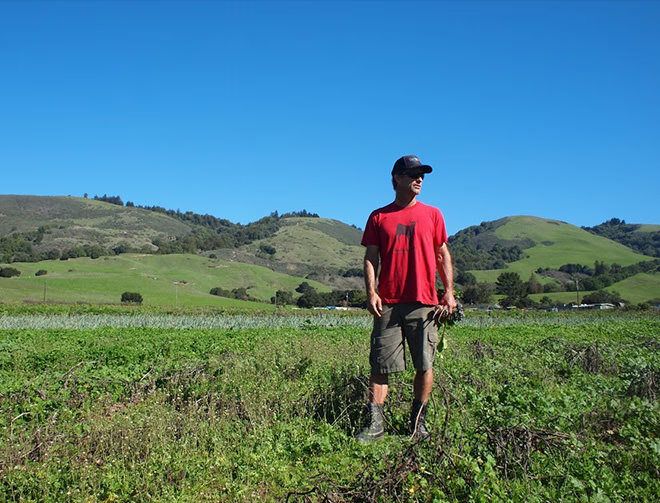
The next place I visited was Joe, who runs a farm called Dirty Grill Produce. He was introduced to me by a friend who runs the very popular ramen restaurant " RAMEN SHOP " in Oakland.
This was a relatively large and spacious farm that we visited this time, and we were shown around it and heard about organic farming that utilizes green manure called cover crops, how to grow vegetables for restaurants, and about the business.
With various questions flying around,
"Why did you start farming?" "What is the issue of farm succession in America?"
In response to this question, he gave us an interesting story.
"Around the time of the hippie movement in the 1960s and 1970s, a movement to return to farming called the 'Back to the Land Movement' arose among young people in cities. I think this was the first big movement. Of course, it's true that children of farming families often choose a different option because they know how tough farming can be, but recently, young people with university educations have been entering agriculture as a way to solve social problems and as an idealist. There are also many activists in the Bay Area community who are working to combat social food issues.
I myself thought a lot about social issues while studying at university, and eventually ended up in agriculture. Then, through internships and other things, I gradually became addicted to agriculture (laughs).
When I look at the world, one way to protest against social problems is to hold up a sign, point a finger and shout, but I want to create new things and show that there are other ways to solve problems, which is why I am farming. It is important for me to carry on farming myself, but it doesn't really matter whether my children carry it on or not.
Joe manages 40 acres of farmland (about 3.5 Tokyo Domes, a small size in American terms), employs 20 workers, and grows mainly crops for restaurants. He has stalls in 10 farmers' markets in neighboring cities, earning 60% of his sales at these direct sales markets, which have the highest unit prices and profit margins. I was impressed by what he said: farmers are highly respected in the Bay Area, just like chefs.
No Input Farming.
Pursuing my own way of life through natural farming.
Kristyn Leach / Namu Farm
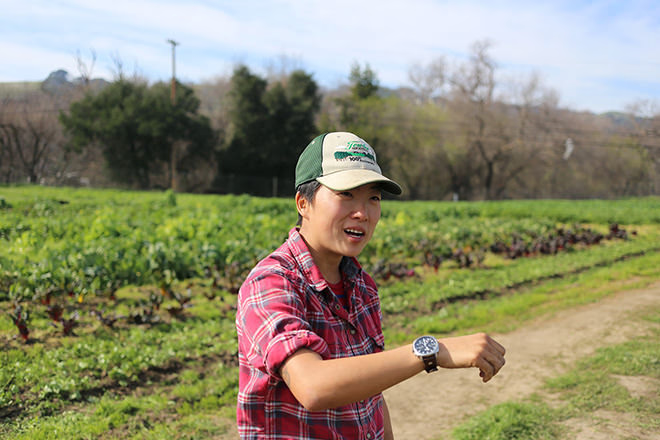
Our last guest is Christine Leach, who runs Namu Farm.
I have an exclusive contract with Namu Gaji , a very popular Korean restaurant in San Francisco, and I am pursuing the farming that I want to do. I was introduced to Namu Gaji by Alison, the wife of the chef at CAMINO, as I also supply vegetables to restaurants such as CAMINO in Oakland.
When I asked him about farming methods, he began the conversation by asking, "Have you heard of Fukuoka Masanobu's ' One Straw Revolution '?"
In fact, I am often asked the same question by organic farmers and restaurant workers, especially those from Chez Paniss in California. Masanobu Fukuoka is a natural farming practitioner from Ehime Prefecture who has spread his unique theories, ideas, and philosophy to the world. (He also visited California in the 1970s.) His grandson has now taken over his farm, and I visited his farm with Jerome a few years ago. I remember it being a very beautiful field, with fields and orchards coexisting without any boundary between them.
Christine's farming method is also natural farming, where she uses almost no produce other than that grown in the field when it comes to soil preparation. The only fertilizer she uses is fermented seaweed, and she also uses green manure (natural grasses that are worked into the soil and decomposed by microorganisms to turn into fertilizer) to prepare the soil. She doesn't use tractors or petroleum fuels at all, and does all her work by hand, using sickles and mulberry trees. She said that working with tools that are easy to repair and replace when they break down suits her better, rather than using large machinery.
This is the fifth year of planting in this field, and while California agriculture has suffered from a lack of rain in recent years, they are able to secure the same yield with only one-third of the amount of water as in the first year. (They keep detailed logs.) They have also contracted with an organic seed distributor and are developing a business selling seeds that they have self-produced through various trial and error.
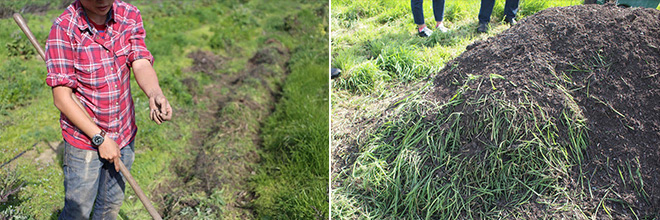
Namu Gaji and CAMINO, who have exclusive contracts with Chez Panisse, are based on the same philosophy as Chez Panisse of "cooking with seasonal vegetables," and they also have an understanding of farming methods, which is what has made the relationship between the two restaurants work.
From what I've heard, her income is about the same as a starting salary in Japan, which is not much, but she finds meaning in being able to do the experimental farming that she wants to pursue, such as growing new vegetables and trying new, laborious methods.
"It's not enough money by any means, but I want to continue experimenting with the farming methods I want to use throughout my life. But when I get older, I won't be able to move my body as much as I can now, so I'm thinking about starting an orchard. My ideal for the future would be to continue farming by combining several small sources of income, such as selling seeds."
We also received some comments on the Food Hub project, which we would like to share with you.
"It's interesting that people from various walks of life are trying to work on this project together. The Food Hub's concept of "supporting farmers and supporting local food" is very important. We considered creating such a place in this area, but we found that there was so much residential and commercial development that there was no land available for farming. The lack of farmland, despite the fact that the food self-sufficiency rate in the neighborhood is very low, is a major problem. We'd love to keep in touch with you to keep up to date on the progress of this project."
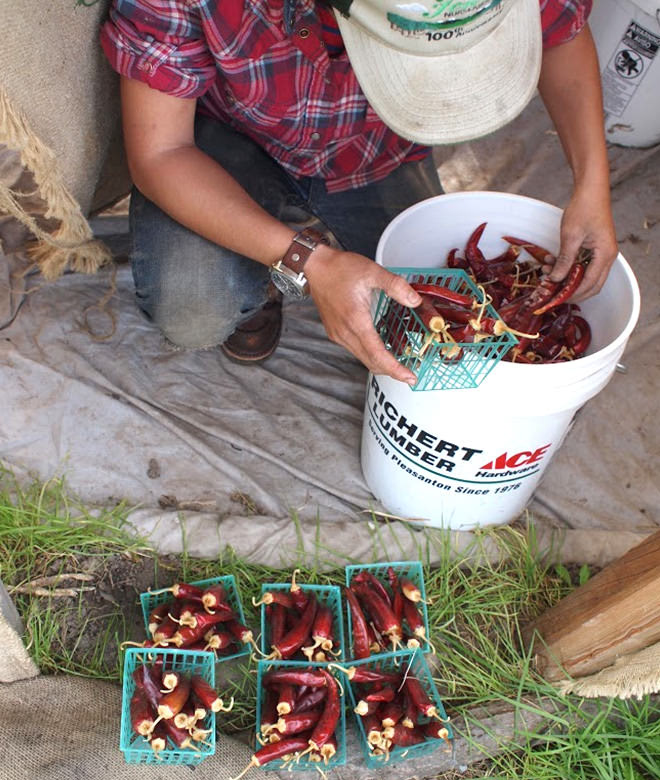
As I was leaving, someone said to me, "Take this red dried chili!"
I heard that chili peppers are very popular with chefs, have a high unit price, and can be sold fresh, dried, processed into powder, and finally as seeds, so they are very profitable. "I always tell young farmers to grow chili peppers," said Christine. I was deeply attracted to her way of thinking, which not only showed her unique commitment to agriculture but also her business sense.
Farm Lifestyle and Social Farming.
Agrarian living and social agriculture.
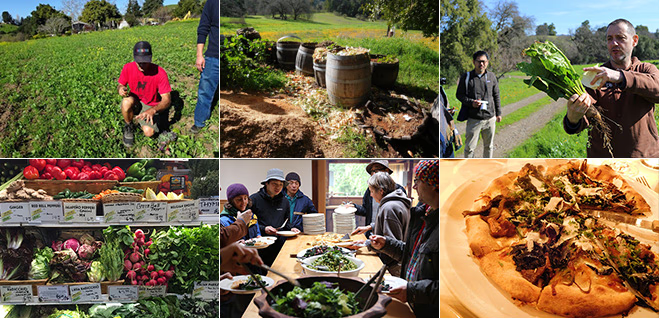
After this visit, members of the Food Hub Project discussed "what kind of farming methods can protect agriculture in mountainous and hilly areas?"
Before talking about farming methods, we discussed whether there is a "farming" as a livelihood, or an "agricultural lifestyle" in which one pursues one's ideals rather than productivity and strives for a life close to self-sufficiency. This "agricultural lifestyle" also includes growing food for oneself and giving away surplus to neighbors. In recent years, this style is common among people who move to the countryside and start farming, and there is no doubt that this "agricultural lifestyle" will play an important role in the food culture of rural areas in the future.
So, what measures should we at the Food Hub Project take to protect agriculture in mountainous and hilly areas?
What I'm thinking now is that rather than just discussing cultivation methods such as natural farming and organic farming, I should farm with an awareness of social issues, just like the farmers I met in California.
It goes without saying that agriculture supports the town's natural environment, local industries, and food on people's tables. I think what's important in this is to reconnect "why we eat" with "why we farm."
To achieve this, we believe that what we should pursue is not just supporting the "agricultural lifestyle" mentioned above, but also "agriculture that brings about positive changes in businesses such as restaurants and in the awareness of people who eat," as Bob, Joe, and Christine have done.
During this trip to the San Francisco Bay Area, I felt strongly that "social agriculture," a way of life that takes into account the challenges facing the world, will be necessary in mountainous areas in the future.
Although it has been a lot of talk, the Food Hub Project will finally get fully underway from April. We hope to be able to share our honest feelings from here again.
